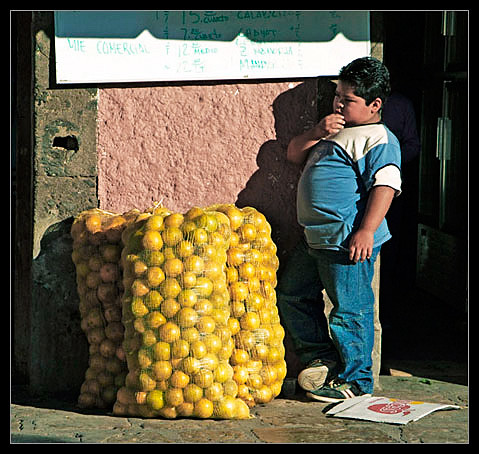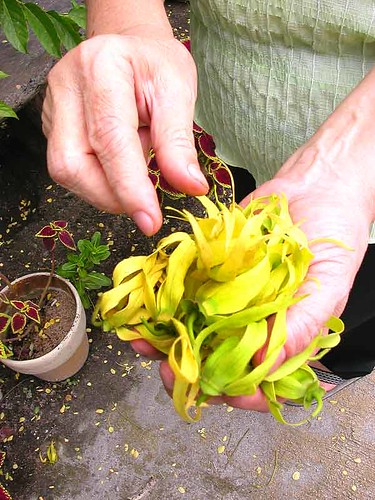In my series “Decoding Obscure Notes” I try to shed light on some notes that have a confused identity or such vague characteristics that they truly required some more explanation.
Vetiver is not quite an obscure note, but there is a lot to be learned and explored in the realm of vetiver. The reason I decided to add it to the series after all is three-fold:
1) Vetiver varieties differ so vastly between each other that the identity or characteristics of “what vetiver truly is” is a bit vague and open to interpretation. Is vetiver a woody note? Is it earthy?
2) Vetiver has been treated in myriads of ways as a soliflore, to the point that I suspect it is a bit misleading. Particularly for consumers who haven’t experienced an authentic vetiver oil. When we look at the different “vetiver soliflores” offered, the source of the confusion and lack of clarity is evident. I am hoping that in the vetiver perfume reviews that will be posted over the next while some of these mysteries will unveil themselves to you.
3) Vetiver as a note is classified in may different ways that can also be quite confusing: it is most often described as “woody” even though it is not a “wood” at all. In other instances it is described as “earthy”, and more recently I have encountered reference to vetiver as being “green”.
Can vetiver be actually be so many things at once?
Let’s try to find out!
So let’s start from the beginning:
WHAT IS VETIVER?Vetiver (Vetiveria zizanoides) is a tropical grass originated in India. It is relative to other tropical grasses such as lemongrass, palmarosa, nagramotha (aka cyperus – not cypress!) and citronella.
Vetiver is now cultivated in many tropical countries in Asia, Africa, Brazil and other places. The best, or the most popular vetiver oils come from Haiti, India, Indonesia, the Bourbon Islands, Sri Lanka and Java.
Unlike most grasses, vetiver roots grow inwards, rather than expand to the sides. The root is quite large and can reach very deep (
up to 2-4 meters!) into the ground. This root structure as well as the manner in which vetiver multiplies make it very easy to control (as opposed to most grasses, which pretty much take over any earth-space they inhabit, ever expanding and multiplyin, and very difficult to control!). This makes vetiver an excellent plant to combat erosion in the tropical climates where it grows. Vetiver is cultivated to protect rice puddles and keep the soil in place despite of the monsoons, without harming the agricultural species.
OTHER USES FOR VETIVER
We mentioned the role of vetiver in preventing erosion. Vetiver has other uses which make it very popular world wide. The plant has a cooling effect in traditional East Indian medicine and folklore, and is considred to be “The Oil of Tranquility” in India, where most of the local vetiver, particularly the “Ruh Khus” (copper distillation of wild vetiver).
Vetiver is also used to cool off in the hot tropical climate. Blinds of vetiver are dampened in the heat, and the cool scent comes in to the house with the breeze. The dried roots are alsoused in pot pourris. Vetiver hydrosol is used in
sharbats (cool drinks) and sweets too (I never tried these yet, but I am determined to do so!).
Vetiver is also used for many other useful purposes: the straw is used in the construction of huts in Africa, and the roots are used as a fuel; The rootlets are used to protect domestic animals from vermin, and the essential oil is used to protect cotton and linen from moth, much like patchouli. Sachets of the rootless can be placed in drawers for the same purpose, and are also hang inside Russian fur coats for protection from insects. Beside their cooling effect and the lovely scent they release, the window screens mentioned above, woven from vetiver roots also help to keep bugs and insects ou of the house. Essential oil of vetiver is added to vegetable preserves, particularly asparagus. To find out more
click on this informative link.
HOW IS VETIVER PROCESSED FOR PERFUMERY USE?Vetiver essential oil is steam distilled from the root of the plant, and is the main type of essence used in perfumery. I am not aware of any other essences (i.e.: absolute or concrete) produced for perfumery use. The root is quite large and can reach very deep (up to 2-4 meters!) into the ground. The yield of oil is quite high as well and so vetiver is one of the more economic building blocks.
The distillation process involves uprooting the plants, washing them from the dirt, than drying them for an extended amount of time. Before distillation they are soaked in water again. After distillation the oil is left to mature several months before being marketed and used. It is quite a process - yet because the yield is large (and the plant matter comes in large doses) it makes it quite an affordable oil, comparing to, for instance, orris root - which also requires a similar process of maturing. Orris, in contrary, is prohibitively expensive.
WHAT DOES VETIVER SMELL LIKE?Depending on the country of origin, different vetiver oil varieties smell completely different. They represent in many ways the soil they are coming from, and this makes the different distillations (from different origins) quite unique. Some are darker and earthier, some are lighter and almost citrusy, some are smoky, some resemble wood, etc. What all vetiver oils have in common is the presence of
vetiverol, which gives them their common sweetness and woody, rooty characteristics. Other principle constituents of vetiver oil are vitivone and terpenes such as vetivenes (based on Julie Lawless'
The Encyclopedia of Essential Oils.I have recently became particularly curious about vetiver and have collected a few interesting specimens from around the world. There are still many vetiver distillations which I’ve never smelled. The following will give you some idea of how vastly different vetivers are from one another, and perhaps lure you into the world of soil, wood and greenery that vetiver evokes so whole heartedly.
Indonesian Vetiver
This was the first vetiver I’ve encountered and I am reluctant to say I was quite repulsed by it in the first place. It reminded me of the dark, yeasty Marmite spread (
click here if you are not familiar with this curious British condiment). I quickly learned that it was a very valuable note, even from this less-than-perfect distillation, although it still to this day creates a strange sensation in me when I smell it within a composition, as if it is stuck in my throat (perhaps a Marmite reminder – a spread I have never quite got accustomed to despite the recurrent efforts of my parents, who spent the best years of their youth eating it while studying in the UK). This vetiver could be described as earthy and perhaps a tad smoky and woody and quite musky. It goes very well within herbal as well as floral compositions, but one needs to be cautious as to how much is used, as this is quite a tenacioius variety. I recently acquired an Indonesian vetiver that is finer, but from a different manufacturer, and it still had almost the same characteristics, yet a tad mellower. I like using the Indonesian vetiver where its harsh qualities will be most useful: in leather and chypre compositions. There, paired by equally tenacious aromas it will add to the mix rather than overwhelm with its presence.
Haitian Vetiver
This is the vetiver that made me fall in love with vetiver as a building block. Up until than, I thought it was only chemicals that made commercial vetivers smell so fresh and lemony. I presume that this vetiver is the variety most suitable for fresh, clean, almost “green” vetiver colognes. It is ethereal and sublime, light and almost airy - and smells almost citrusy on its own, but not quite. The variety I have is of wild vetiver from Haiti. If I had to pick only one vetiver to use, this would be it. I also tried another variety (not the wild one), which is similar only with a top note reminiscent of
Jerusalem Artichokes - very rooty and earth-invoking, yet somewhat heady and sweet; and with a body note that is quite woody and reminiscent of
Amyris (aka West Inidian Sandalwood).
Vetiver Bourbon
My personal second favourite (even though it is considered finer than Haitian vetiver, right next to vetiver from Java – both of which are extremely rare to come across), this vetiver is still very smooth, but warmer, rounded and just a touch smoky.
Sri-Lankan Vetiver
This vetiver is so different I almost didn’t believe it was vetiver. Now, talking about woody… This one has almost no trace of earth. It smells like wood – driftwood to be precise – and you’ll almost think it is some kind of a fake sandalwood. I use this variety when I am looking for a woody note, without the need for a recognizable vetiver note. It is particularly marvelous with florals, lending a rich, deep woody fixative but still letting the florals stay at the centre of the stage.
Madagascan Vetiver
I haven't worked much with this variety, but I do have a sample of an organic oil from Madagascar. It is closest to the Haitian vetiver, only woodier and with a certain floralcy to it. It's not as smooth and woody as the Sri Lankan vetiver, but it has the typical underlining clean/earthy/sweet that makes vetivers so charming.
Indian VetiverIndian vetiver is the most earthy and rich of all the vetiver I’ve smelled. I would like to mention to particularly interesting specimens I have recently got from White Lotus Aromatics. Christopher McMahon, the proprietor, is a
self-confessed vetiver connoisseur, and I think I got infected by his passion – which is quite understandable: there is something utterly intimate about getting in touch with the roots of foreign countries. Vetiver roots being fully enveloped in earth for the longest time, soak many of the qualities of the land they come from. This makes for a very interesting experience of visiting far away countries with a simple uncorking of a vial…
Inidian Vetiver co-distilled with Mitti (Baked Earth)
As if Indian vetiver wasn’t earthy enough to begin with, this artisan distillation marries the essence of vetiver with that of baked Indian earth. What does it smell like? You guessed it: dirt.
Ruh Khus (Wild Indian Vetiver)
While all the other vetiver oils I mentioned earlier are in different shades of amber, Ruh Khus is a dark blue-green. The reason is simple: this oil is distilled in the traditional Indian way, in copper vessels. The copper lends its unique colour of oxidation (turquoise) to the oil, as well as a tinge of metallic aroma. Copper vessels are relatively light and the Indian perfumers have the custom to travel with them to the place of harvest, to gather the plants and distill them on the spot. This flexibility is highly important for the traditional Indian perfumers, because this way they can easily travel from place to place and distill rare essences in remote places – as opposed to importing the raw harvest to a remote atelier, by which time the essences will be either gone or spoiled.
There are two more interesting vetiver varieties that I am interested in trying, and I will add them later to SmellyBlog once I’ve obtained and evaluated them. I am curiosu to explore more distillations of vetiver from around Madagascar - Reunion, Comoro and the Bourbon islands, and also of South African Vetiver.
VETIVER’S ROLE IN PERFUMERYThe versatility of vetiver as well as its wide availability, reasonable price and high yield of essential oil make it an extremely valuable note in the perfumer’s palette. Whether if you are looking for a fixative for a floral bouquet; a woody nuance in an incense, oriental or chypre scent – or if you simply wanting to go all the way with the earthy characteristic of this abundant root – vetiver proves to do its job and do it well.
Vetiver is said to be used in about 36% of perfumes today. I anticipate that now, with the decline of the use of oakmoss, vetiver demand will be increasing (until it is going to be listed for an IFRA embargo like most valuable natural essences; I hope to be proven wrong in that matter).
MY PERSONAL DISCOVERY OF VETIVERAs first I was quite repulsed by it personally. The variety I first came across smelled an awful lot like marmite, as I mentioned above.
What made me more drawn to vetiver was the perfume Mitsouko. I first found it to be very dry (a characteristic that the vetiver highly amplifies). But after I worn it a few times, carefully observing its metamorphosis over time, the peculiar scent of vetiver has captured my heart: being at once dry, woody, earthy, clean and sweet. It sounds like an impossible combination, but that is what vetiver is to me.
My favourite is the Haitian vetiver. It has a very clean, cool scent, and feels light - almsot citrusy. The vetiver in Guerlain's Vetiver smells a lot like it.
I am currently so intrigued by vetiver that I am determined to create my first non-floral soliflore with the theme of vetiver. I am hoping to share the phases and ideas of development here on SmellyBlog, as well as share the scent with you as it evolves and takes shape.
RECOMMENDED PERFUMES WITH RECOGNIZABLE VETIVER NOTEAgent ProvocateurBlack Vetiver Cafe (Jo Malone)
Megumi (Ayala Moriel)Mitsouko (Guerlain)
No. 5 (Chanel)
No. 19 (Chanel)
Sabotage (Ayala Moriel)Sycomore (Chanel)Turtle Vetiver (LesNez)
Vetiver (Guerlain)
Vetiver Extraordinaire (Frederic Malle)Vetiver Racinettes (Ayala Moriel)Vetiver Tonka (Hermes)
Vetiveru (Commes de Garcons)
Some of these perfumes and a few more will be reviewed over the next few weeks as part of a "Vetiver Marathon".
You can also find reviews for these Vetiver titled perfumes, though in my opinion they are not good representatives of the note (yet interesting perfumes on their own rights):
Vetiver 46 (Le Labo)
Vetiver (Lorenzo Villoresi)Vétiver Oriental (Serge Lutens)
* If you have a favourite vetiver that you'd like to see reviewed on SmellyBlog and does not appear on the above list,
please let me know. I will do my best to review it if I can find it in Vancouver (or if you are willing to send a sample). The above are vetivers that I tried and liked and have access to.
SUMMARYTo make a long story short – I will try to answer the question posed in the title of this essay: Is vetiver earthy, woody or green?
The answer is, of course, “all of the above”.
Some varieties are earthy (particularly the Indian and Indonesian distillation), which makes particular sense, considering the fact that vetiver is a root covered a few meters deep in soil.
Some are woody (the Sri Lankan vetiver exemplifies that) which should’t be such a shock if recalling that patchouli oil, distilled form leaves of a plant from the mint family, is also considered woody (as well as earthy).
And some vetivers are considered green (such as the Haitian Vetiver variety), as if they were some leaves or grass – which actually is exactly what vetiver is! For whatever reason, some varieties amplify the grassy or green characteristics more than others.
The quality of vetiver all depends on the soil in which it originated from, as it soaks up many characteristics of the earth.
Vetiver is a very important perfume material, and is used in more than third of the perfumes today, and in all fragrance families.
References ("Real Book" Bibliography, besides the links sited above):
Perfume and Flavour Materials of Natural Origin by Stephen Arctander
The Encyclopedia of Essential Oils by Julia Lawless
Aromatherapy and the Mind by Julia Lawless









